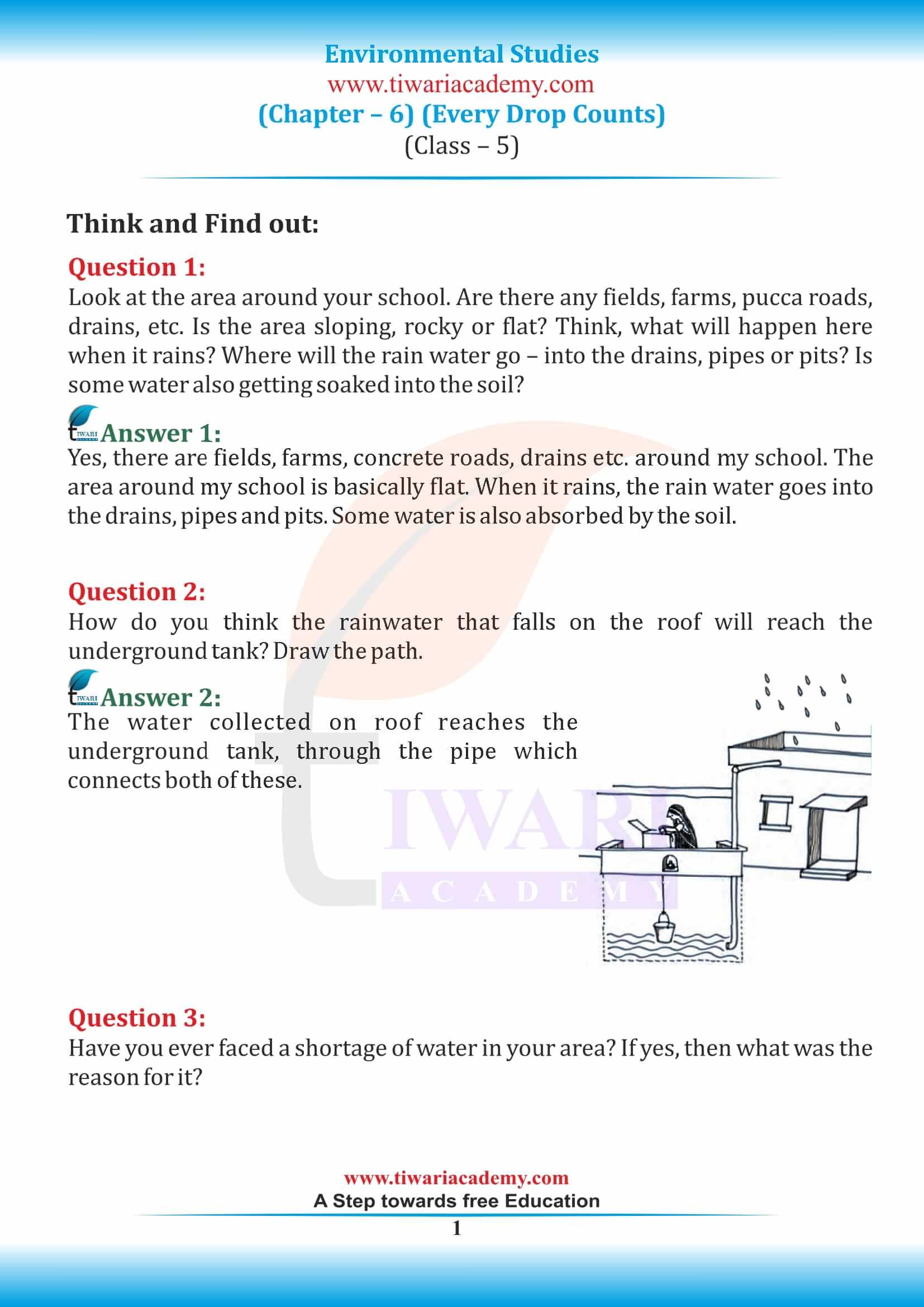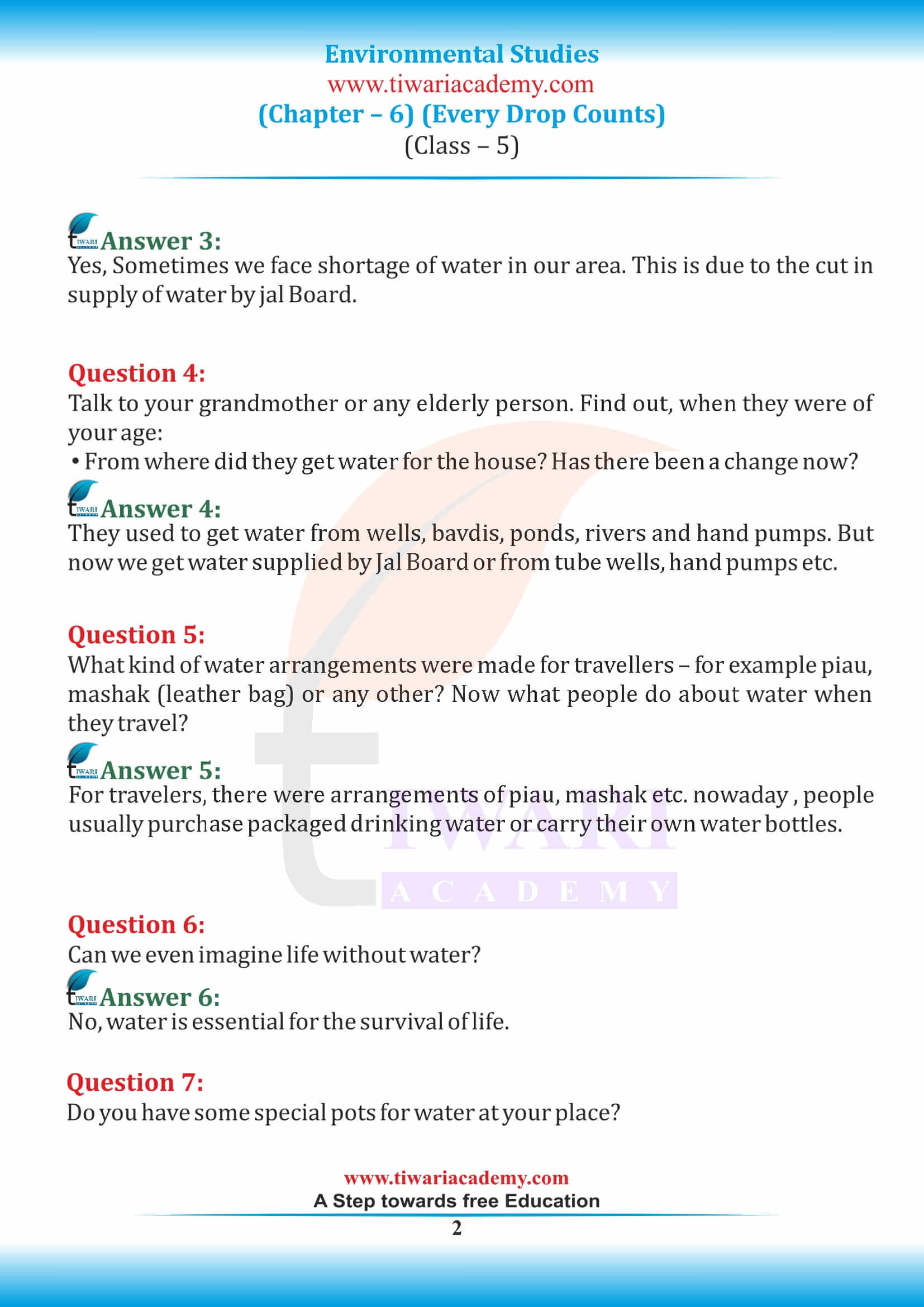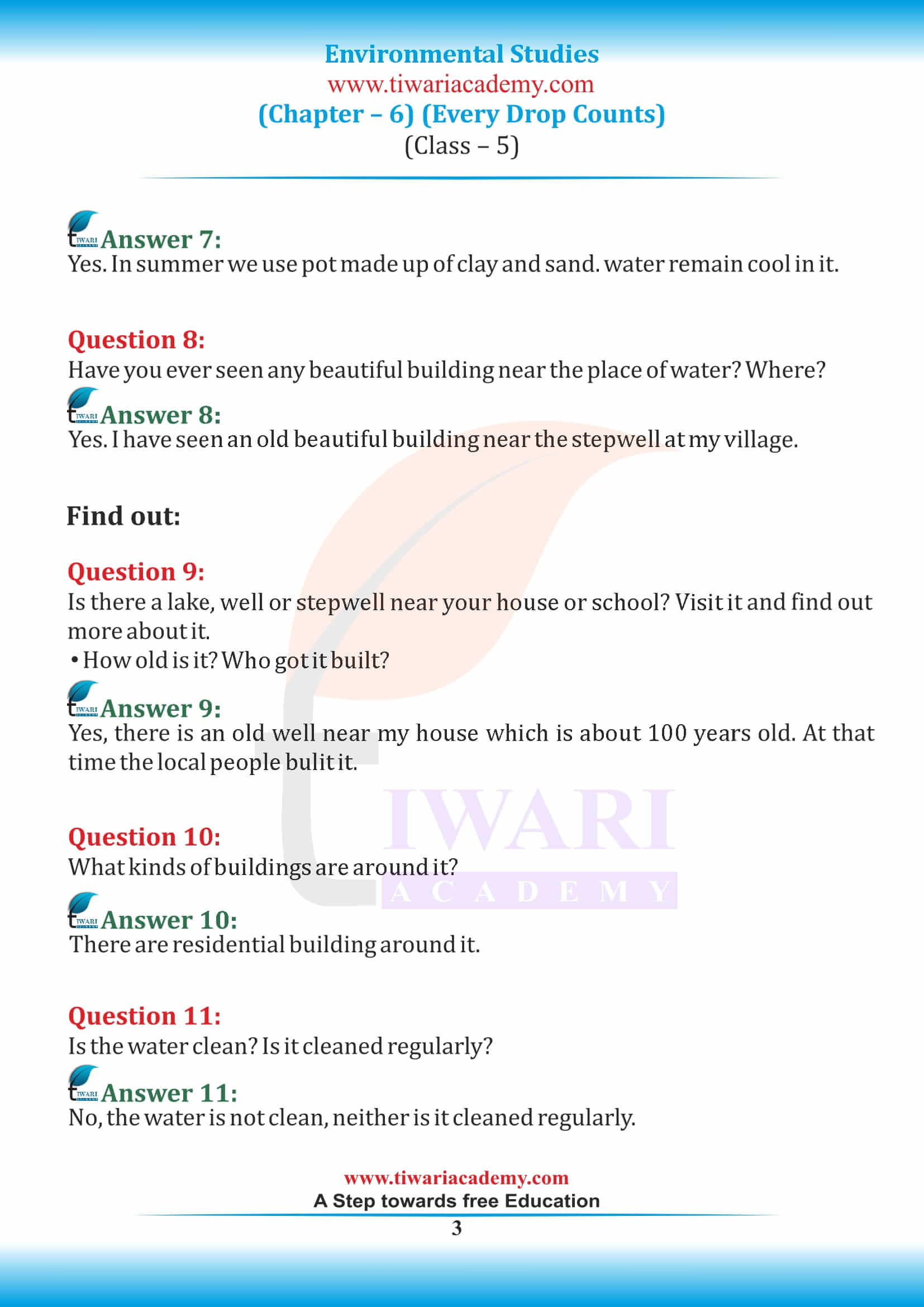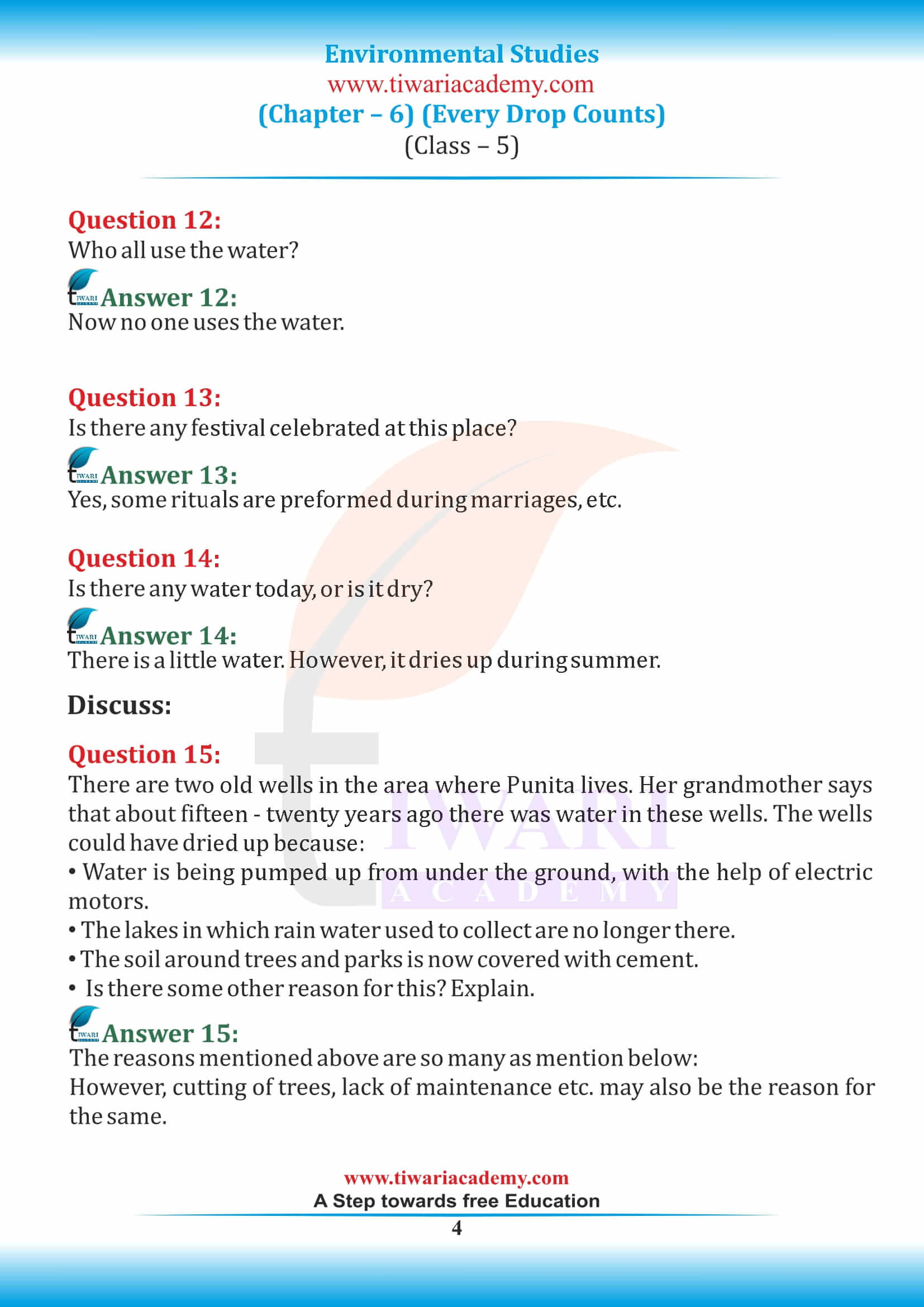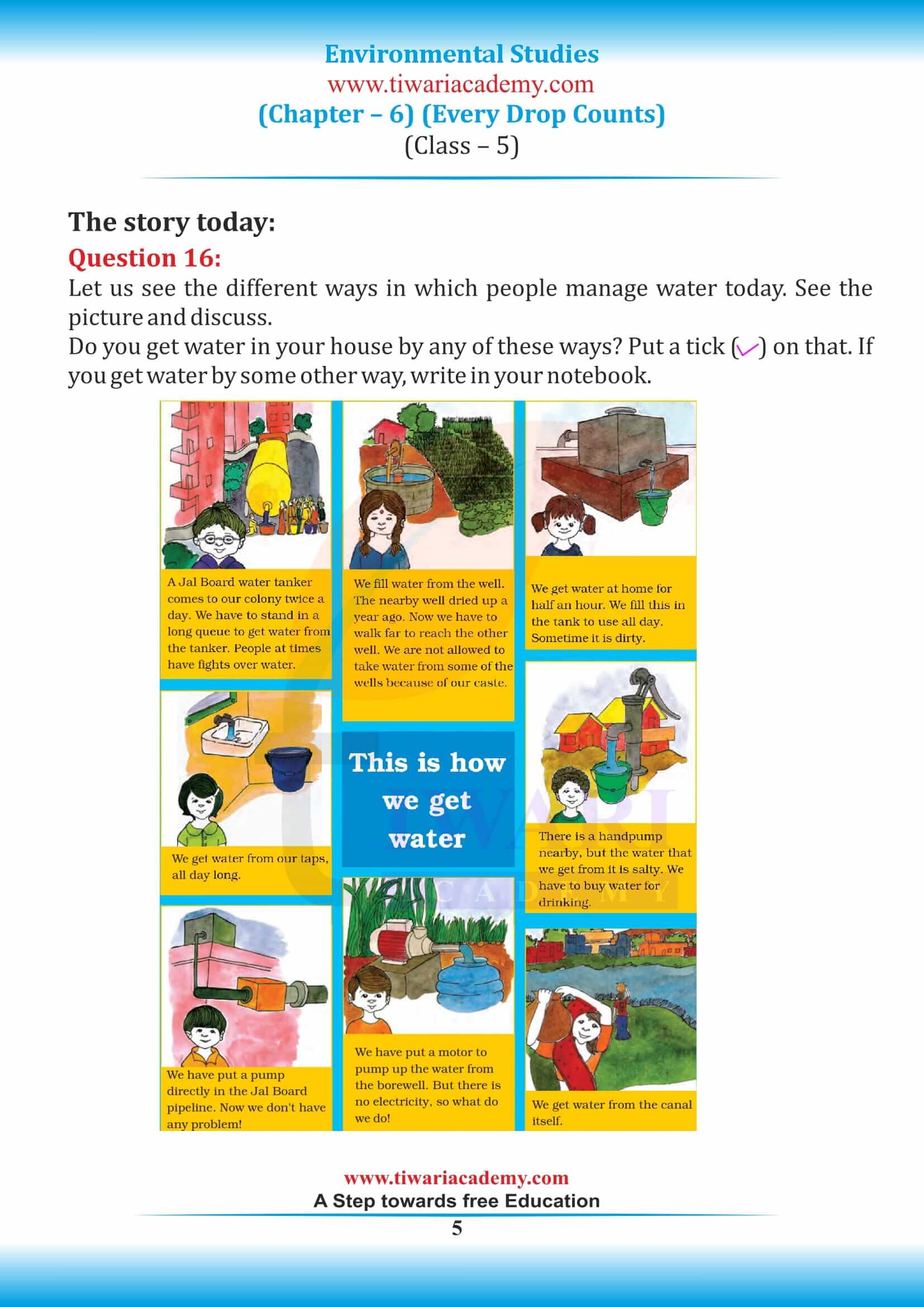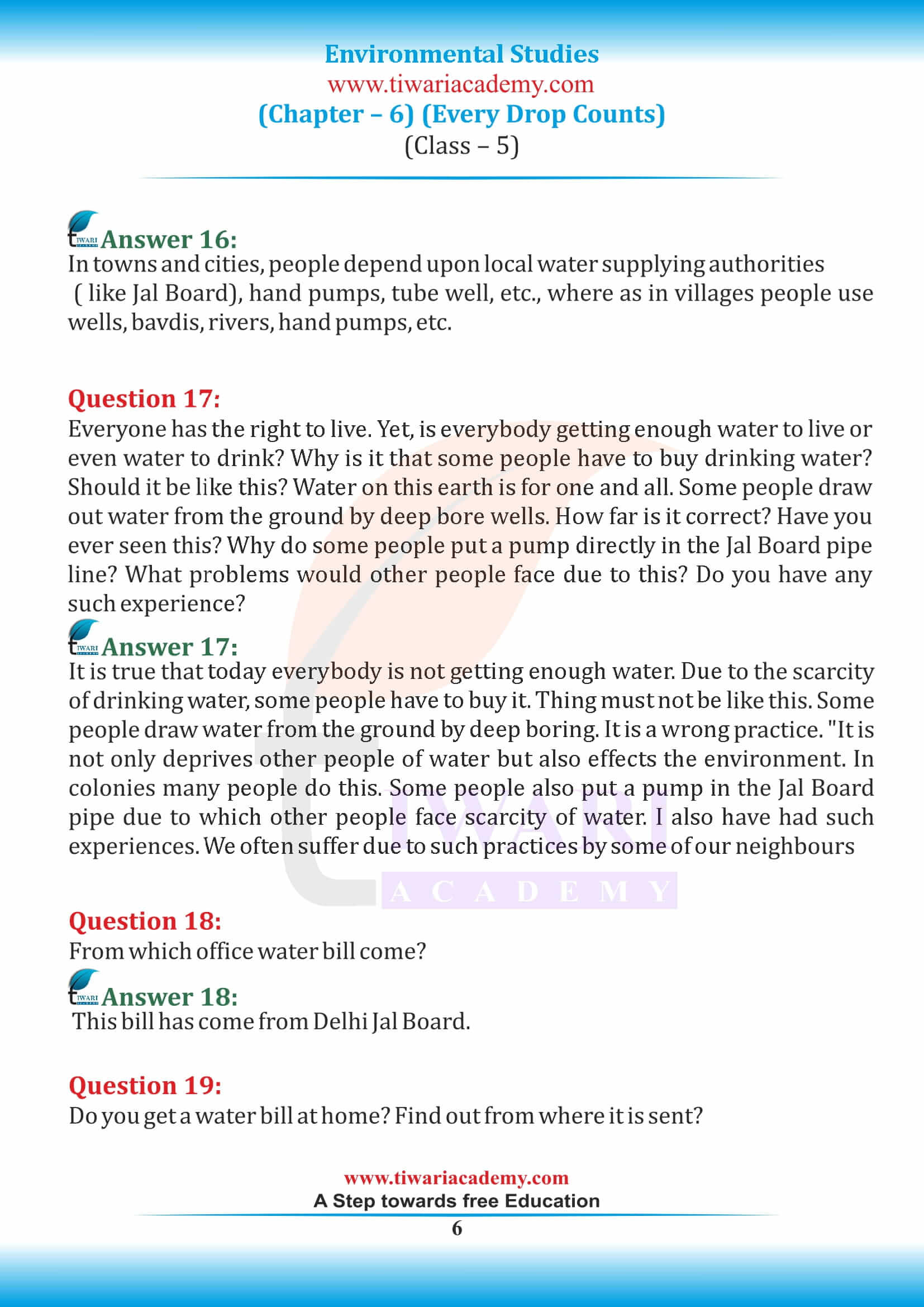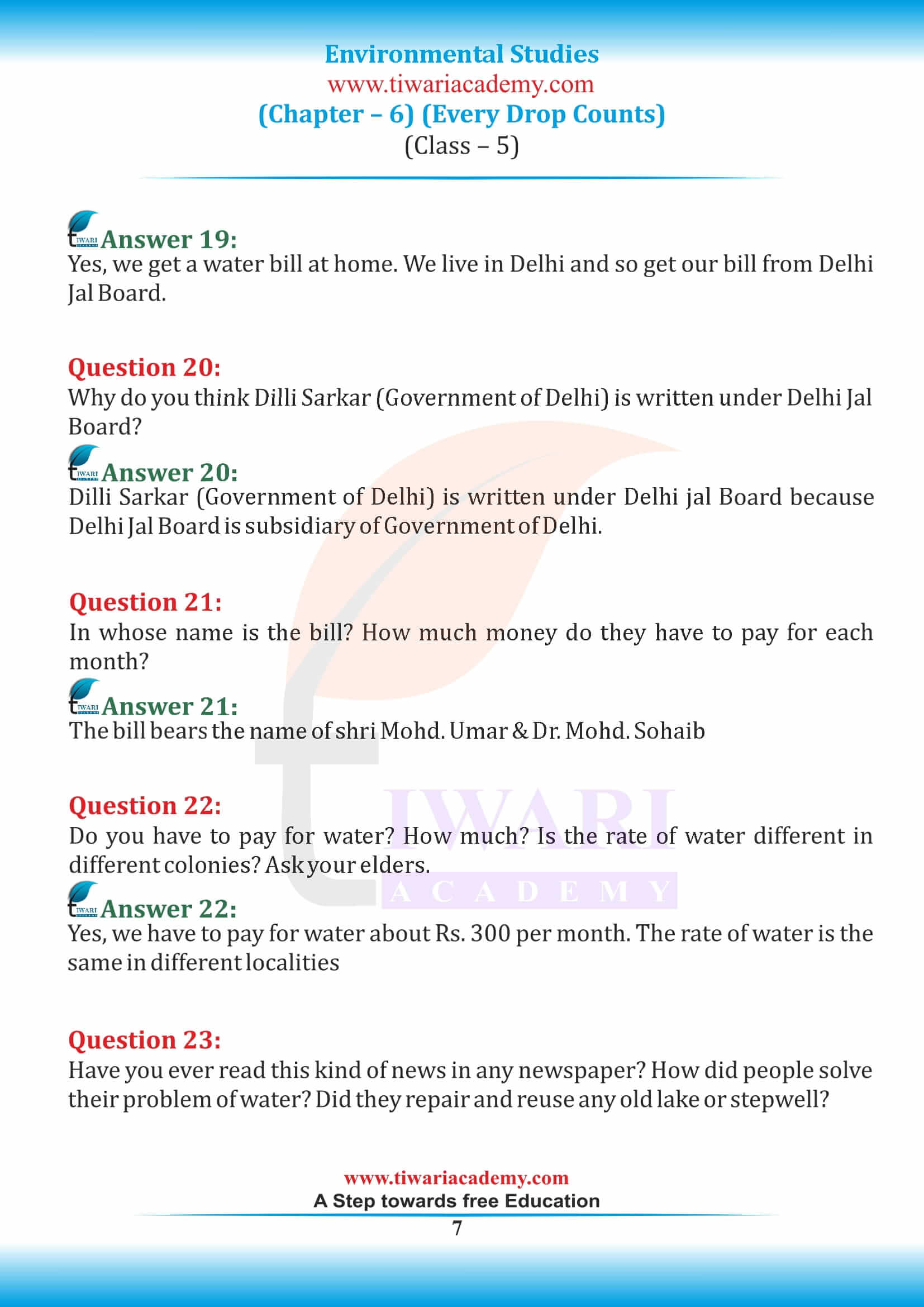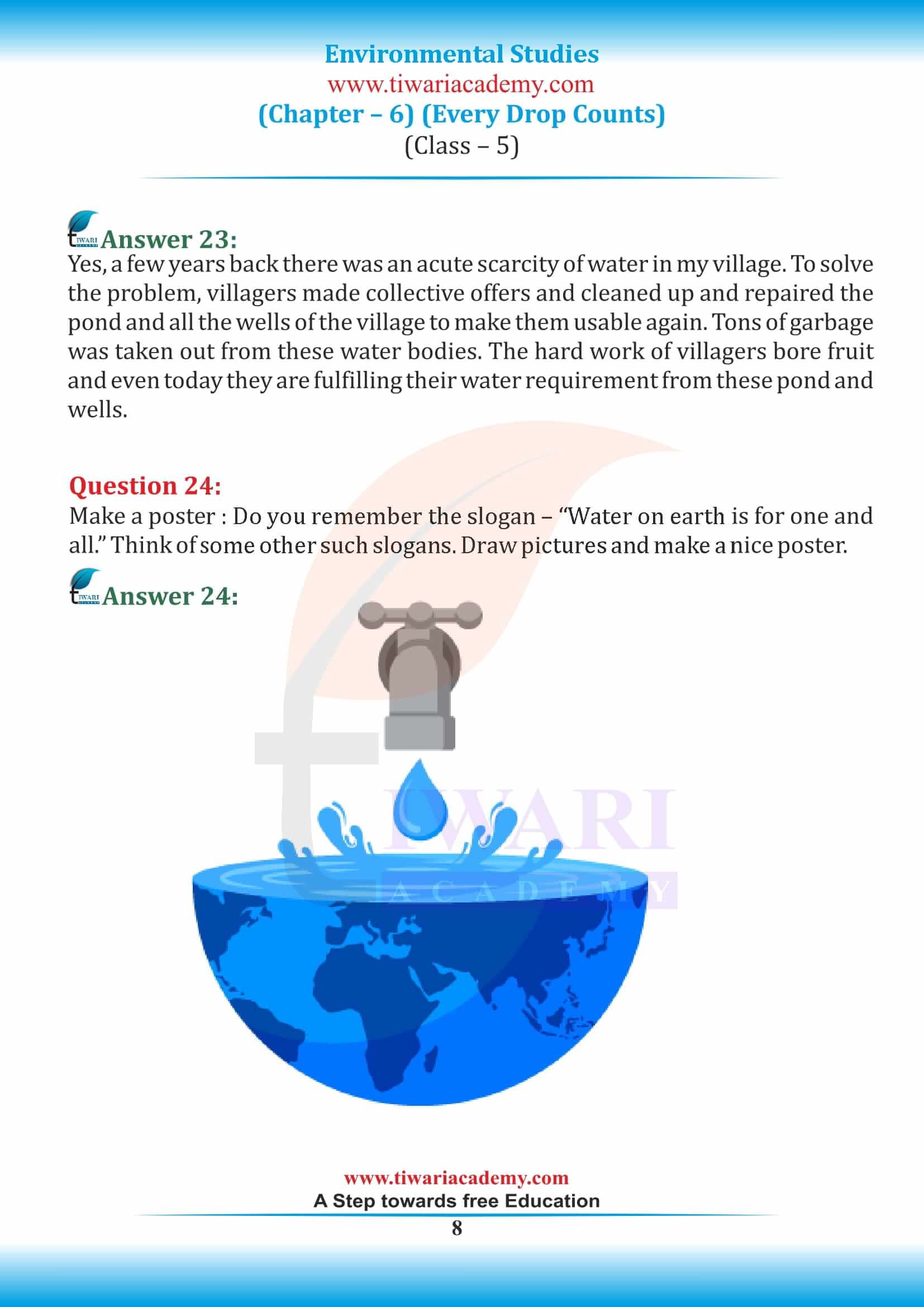NCERT Solutions for Class 5 EVS Chapter 6 Every Drop Counts in English and Hindi Medium PDF and Video format updated for new academic session 2025-26. Answers of grade 5 EVS chapter 6 are given here in simple format, easy to learn for everyone. These questions are much helpful for the preparation of exams and school tests. All the contents available on Tiwari Academy is free to use without any registration.
NCERT Solutions for Class 5 EVS Chapter 6
Class 5 EVS Chapter 6 Question Answers of Every Drop Counts
Class 5 EVS Chapter 6 Question Answers Set 1
What is Ghadsisar?
King Ghadsi along with the people built a lake known as Ghadsisar, to help the people. Sar means a lake. Ghats were also built around the lake.
When and why was Ghadsisar built?
King Ghadsi of Jaisalmer got it made 650 years ago with the help of the people and provide them with water. All around the lake are ghats which have steps leading to the water along with decorated verandahs, large halls, rooms etc. People came here and celebrated festivals and had programmes of music and dance. Children came here to study in the school which were on the ghats. The talab belonged to everyone and everyone took care to keep it clean.
Who was Al-Biruni?
Al-biruni was a traveller who came from Uzbekistan to India more than a thousand years ago. He wrote about Indians and their being skilled at making ponds. He wrote about how they used to pile up huge rocks joined with iron rods to build chabutaras around the lake.
What is a step well? Why is it called so?
A step well is a kind of well in which water can be reached by walking on a set of steps. They are also called bawdi or baoli in India and are used to store water. In the early times were also used to irrigate crops.
What is rain water harvesting?
Rainwater harvesting is a method which is used to conserve the rainwater by collecting, storing and purifying it when it runs off from rooftops, parks, roads, open grounds, etc. There are two ways of doing rainwater harvesting-
i. surface runoff harvesting
ii. rooftop rainwater harvesting.
Rainwater harvesting is thus the collection and storage of rain for reusing it
How did the people of Rajasthan save water in the ancient days?
The houses in Rajasthan in the ancient times were constructed with stone and lime and their roof was diverted to Tankas. Every house had underground tankas to store the water for drinking purposes. These tankas were large and deep tanks which were built inside the main house or the courtyard. They were linked to the sloping roofs of the houses through a pipe. The houses and buildings in urban areas were built in such a way that they had large roofs and the roof-top rainwater could be conserved and used for recharging the groundwater.
Why are wells drying up nowadays?
The wells have dried up as water is being pumped out from under the ground by using electric motors. The lakes in which the rain water used to be collected are no longer there. The soil around trees and parks are now covered with cement.
Moreover, due to the warmth in the air the process of evaporation is growing fast and more water is being evaporated. So, wells are drying up nowadays because of heat.
How was rainwater used in Rajasthan in the ancient days?
Rainwater collected in the lake was spread over many miles. It was made in such a way that when the lake was full, the extra water flowed into another lake at a lower level. When that too was filled up, the extra water flowed into the next lake. This way there were nine lakes which used to get filled up. This rain water could be used throughout the year.
What has happened to Ghadsisar now?
Ghadsisar is no longer in use. Many new buildings and colonies have come up in between those nine lakes. Now the water does not get collected in these lakes. Rain water just flows away and is wasted.
Class 5 EVS Chapter 6 Question Answers Set 2
Why was there no scarcity of water in the ancient days?
Many places in Rajasthan, get very little rainfall. Here it rains for only a few days in the entire year sometimes not even that much. The rivers here do not have water all around the year. And yet, most of the villages in these areas did not have a shortage of water because in earlier times there were many stepwell, piaus, baolis and johads in Rajasthan so that time people didn’t face water shortage in earlier times.
How was water available to the people in the ancient times?
Water was available to the people as there were-
• Stepwells which had a built-in a cylinder well provided water for drinking, washing, bathing, and the irrigation of crops. They also served as cool sanctuaries for caravans, pilgrims, and other travellers during the heat of day or overnight.
• Johads is a rainwater storage tank which was used in the state of Harayana and Rajasthan. It collects and stores water throughout the year that could be used for the purpose of drinking by humans and cattle. Johads are called as “khadins” in Jaisalmer.
• Baolis is a reservoir in which water can be stored. It is also a source of ground water. Many tanks and baolis were made by the ruling kings in which water was collected mainly during the rainy season and was then used throughout the year by the people in the neighbourhood.
• Piau- In the earlier times, the kings or the leaders built piau for the travellers form where they could drink water. People also used to carry Mashak, a leather bag which was used to store water.
How does the earth soak water and how does it reach wells and stepwells?
There is a huge difference between the earth’s soil particles and thus as a result it is able to soak water. When it soaks water, it enters into the well and step wells like the process of evaporation. Step wells are the ponds or wells in which the water level is achieved downward through set of straps. They are multi-storied so they turn on the water wheel to increase the level of water from first to second floor at the same time.
What is water cycle?
There are four stages in the water cycle. They are:
• Evaporation
• condensation,
• precipitation
• collection.
The water cycle is a continuous movement of water within the Earth and atmosphere. The water evaporates into water vapour, condenses to form clouds, and precipitates back to earth in the form of rain, snow, hail or sleet and falls from clouds in the sky. Water in different phases moves through the atmosphere (transportation).
What are the causes for water scarcity?
The causes for water scarcity are:
(a) Less rainfall
(b) water scarcity in drought-prone areas
(c) difference in rainfall received by different areas
(d) over-usage of water
(e) wastage of water
(f) unequal access to water
(g) more demand due to increasing population.
People get water from very old lakes, dharas, stepwells and naulas as there are many customs and festivals are related to water. At some places, whenever lakes get filled up with rainwater, the people gather around the lake to celebrate. For example- After getting married, the bride who comes to the new village bows to the spring or the pond. In cities, there is a custom of the bride worshipping the tap
Why is life impossible without water?
Life is impossible without water because we greatly depend on water for our survival. Animals and plants cannot live without water because 70 percent of the human body is water. All living things need water to survive. We need water for doing household work like bathing, washing, cleaning etc. Water is also needed for growing crops, irrigating the fields.
So, no one can imagine to live without water. It is possible to live without food for one or two days but without water it is impossible. If there is no water on the earth then life without also be impossible.
How can we reuse the waste water? Ans.
We can reuse the waste water by following the given ways-
• By using water collected from Ac for mobbing or cleaning the car
• reusing water used for washing vegetables, fruits or cooking.
• trapping rainwater.
• Reusing laundry water
• Redirecting drain water
What are the reason for unequal distribution of water?
Water is not evenly distributed all around the world. Many areas in the world receive very little water from rainfall The ground and surface water resources that are available on earth are not enough to meet the requirements of the growing population like drinking water, irrigation of crops etc. The building of dams along the rivers make them not much powerful.
Question:
What is mashak?
Answer:
Mashak was used for carrying water. It is a traditional water-carrying bag, usually made of waterproofed goat-skin, used by travellers in earlier times, especially in desert areas.
Class 5 EVS Chapter 6 Question Answers Set 3
What is a solution?
A solution is a homogeneous(uniform) mixture of two or more components in which the particle size is small. For example- sugar in water and salt in water solutions, soda water, etc. The particles are evenly distributed in a solution.
What is the difference between soluble and insoluble substances?
There are certain substances which dissolve in water very quickly and easily. Such substances are called soluble substances. Example-When we mix sugar or salt with water, the sugar/salt dissolves to make a transparent solution.
But at the same time there are certain substances which do not dissolve in water and the particles are clearly visible in water. Such substances are called are called insoluble substances. Example-when we mix chalk powder in water, it does not mix in it. It settles down at the bottom of the water.
What is Jal Board?
Jal Board is a government agency which is responsible for supplying potable water to the people of different areas. For Example: Delhi Jal Board is providing water to most of the National Capital Territory regions of Delhi.
How do people get water in cities and towns these days?
The main source of supplying clean drinking water in rural and urban India is Municipal water supply The water is then sent through a vast network of pipes and pumping stations to our homes, apartments and office buildings.
Every town or city has a core water source. Water is stored in amenities such as reservoirs, water tanks, or water towers around the city so that it can be distributed to different areas. Pressure pumps have also been installed to push the water through the pipes to our house. This clean water travels through the pipes to our house. In Delhi, the Jal Board is responsible for supplying water to our houses.
What is a Solvent?
A solvent is a substance which dissolves a salute to make a a solution. A solvent is usually a liquid but can also be a solid, a gas. For example- water is a solvent in which sugar which is a solute is mixed to make a solution.
What is a solute?
A solute is that substance that dissolves in a solvent to produce a homogeneous mixture. Example-sugar, milk etc.
How can we purify water in the modern times?
There are different ways of purifying water in the modern times. Some of the methods are –
i. Boiling: It is one of the simplest way to purify drinking water. Boiling water for about 10 minutes can kill the germs which are present in the water and make it safe for drinking. We should store the boiled water in clean and covered pots or pans.
ii. Filtering insoluble solids from a liquid by using a filter paper or a cloth is called filtration.
iii. Adding chlorine tablets or by adding alum, by filtering and mixing chlorine tablets is another way of cleaning the water.
iv. Using water purifiers like Aquaguard, Kent RO also help in removing impurities and cleaning water.
How can we conserve water?
Water can be conserved by following ways-
• Reducing the unnecessary use of water so as to avoid its wastage,
• reusing the water using all probable ways and methods
• reducing the use of showers and the bucket for the bath,
• closing the running taps when not in use,
• checking the leakages of water and get them repaired immediately.
• Creating awareness and spreading the knowledge about importance of saving water.
Class 5 EVS Chapter 6 Question Answers Set 4
What were the method used for cleaning water in earlier times?
Various methods were used in the earlier times, such as boiling, straining through a cloth and exposing to sunlight. People also built sand filtration columns in which as the water trickled down slowly through the column, the water was cleaned. When using soil or sand as a filter, particles that might be harmful used to get stuck in the little gaps, or pores. This small stuff gets trapped as the water continues to flow down.
What is a chabutra?
Chabutra is a raised platform around a lake. It was designed only for feeding and resting of birds. The enclosure of the chabutras is like an octagonal house with a conical dome and with windows.
What is water table very short answer?
Water table, also called groundwater table, upper level of an underground surface in which the soil or rocks are permanently saturated with water. The water table separates the groundwater zone that lies below it from the capillary fringe, or zone of aeration, that lies above it.
What does replenishing water table means?
Water which is used directly usually comes from flood flows, water conservation, recycled water, desalination and water transfers. During the process of hydrologic cycle, replenishment of water table takes place naturally when rain, storm water and the flow from rivers, streams and creeks seeps into an aquifer.
What are the advantages of rainwater harvesting?
The advantages of rainwater harvesting are:
• It is a cheap method of collecting and using water and is thus a cost-effective method
• It helps in conserving water
• It reduces the problems faced due to shortage of water
• It is a source of water for countryside irrigation
• It is a very simple method of conserving rain water and can be practiced easily
• It reduces soil erosion
• It stops pollution of water bodies which is caused due to fertilizers and pesticides
How do people get water at home in India?
People in the earlier times got water from wells, bavdis, ponds, rivers and hand pumps. But in the present time we get water supplied by Jal Board or from tube wells, hand pumps etc but due to scarcity of water, at some places water is supplied through water tanks or at some places people have to buy water. Some take water from wells and some from canals. Some use hand pumps to get water.
How does the rainwater collected on the roof top reaches us?
The rainwater which is collected on the roof tops reaches us with the help of the pipes which are connected to the roof. These pipes carry the water to the underground tank from where it reaches us. It can be directly linked to our taps too through these pipes and we can use it easily.
Who was Darki Mai?
Darki Mai was living in a village in the Alwar district of Rajasthan. The women of this village used to spend their entire day by looking after their home and animals. At times, they used to pull water for the animals from the well whole night. During summer when the wells used to dry up, they had to leave the village for water.
Class 5 EVS Chapter 6 Question Answers Set 5
What is a water bill?
Water bill is a bill which we get as per the amount of water one has used over a month. One must pay to use water and sewage services each month, which are provided by a municipality. Water bills are thus calculated on the basis of one’s usage, for example- the ones who use more water are charged more.
Who runs the Tarun Bharat Sangh?
Rajendra Singh, an Indian water conservationist who belongs to the Alwar district, Rajasthan in India, runs this Tarun bharat Sangh which was founded in 1975. He is also called the “waterman of India.
Enlist the work done by Tarun Bharat Sangh.
The work done by Tarun Bhagat Singh can be enlisted as follows-
• reviving traditional water harvesting methods
• digging of ponds,
• recharging of ground water aquifers and
• reviving of dying rivers
• reviving 11 rivers in the state of Rajasthan establishing about 11,800 johads.
How was the problem of water shortage solved in Jodhpur in the year 1986?
In the year1986, there was no rain in Jodhpur and the surrounding areas. People that time remembered the old and forgotten method to get water which was the stepwell (baoli). They cleaned the stepwell and more than two hundred trucks of garbage was taken out of it. People of the area collected money. The thirsty town got water from the stepwell. But after a few years it rained well and again and the stepwell was again stopped being used by the people.
What efforts can you make for saving water in your country?
The efforts which I can make are-
i. Avoid wasteful usage of water
ii. Use clean container for storing water
iii. Promote and contribute towards rain water harvesting
iv. Keep the water containers covered
What is Rehat?
Rehat is a water wheel which is a partly submerged vertical wheel with buckets attached to the rim. When the animal turns the wheel, the buckets that are attached to the rim will also turn and the bucket gets filled with water.
Explain the following water sources. 1. Wells 2. Tube wells 3. Canals 4. Tank
1. Well- It is an ancient way of supplying water for irrigation. Wells are dug to reach the ground water. And the water is lifted up by using a Perisan wheel called Rehat. But now electric pumps are being used to draw water from the wells.
2.Tubewell- We can draw the underground water using tube wells. A deep bore is made by using a drilling machine and the water is drawn out using electric pumps. Water is then sent to the fields.
3. Canals- They are an important source of irrigation in India. Water from the main river is diverted in to small human made channels which is then used to irrigate the fields.
4.Tanks- Tanks are built to collect rain water which is later used to irrigate the fields.
Question:
How did the group called “Tarun Bharat Sangh” help Darki Mai?
Answer:
During summer, when the reservoirs were dried up, people had to move to other places by leaving their village. When Darki Mai came to know about Tarun Bharat Sangh, she requested for help. And as a group, the people from the village and Sangh decided to make a pond and solve the problem created by water shortage.
What Does chapter 6 of class 5ht EVS teaches us about nature?
The chapter indeed tells us about the preservation of water from an area where the annual rainfall is less. That makes the people realize the value of water earlier than other people. This makes them forced to get the ideas to collect the water and create something that can store the water for later usage.
Why does the praise from Al-Biruni is significantly important for the place that is given in chapter 6th of class 5th EVS?
The chapter has a small article where the praise for the people who build such a structure from the resources available near to collect the water. The praise is important because the time Al – Biruni came to the part of the are from a country far away even now days took a long time to reach here and he is also from a desert country where the rainfall is less and he praised the community is a significant event for them and that is why it is been mentioned in the story.
Do you get any other ideas to save rainwater after reading the story given in chapter 6th of 5th standard EVS?
There are several ideas that are being implemented by the government too for rainwater harvesting and the ideas that I have got is as follows: –
• We can make the structure in our home basement in which we can collect the water.
• We can make more ponds in the barren lands in the area which is not being used.
• Even on the terrace, we can build a separate water tank that can collect the water so we can use it to wash the plant and for the odd jobs too.
